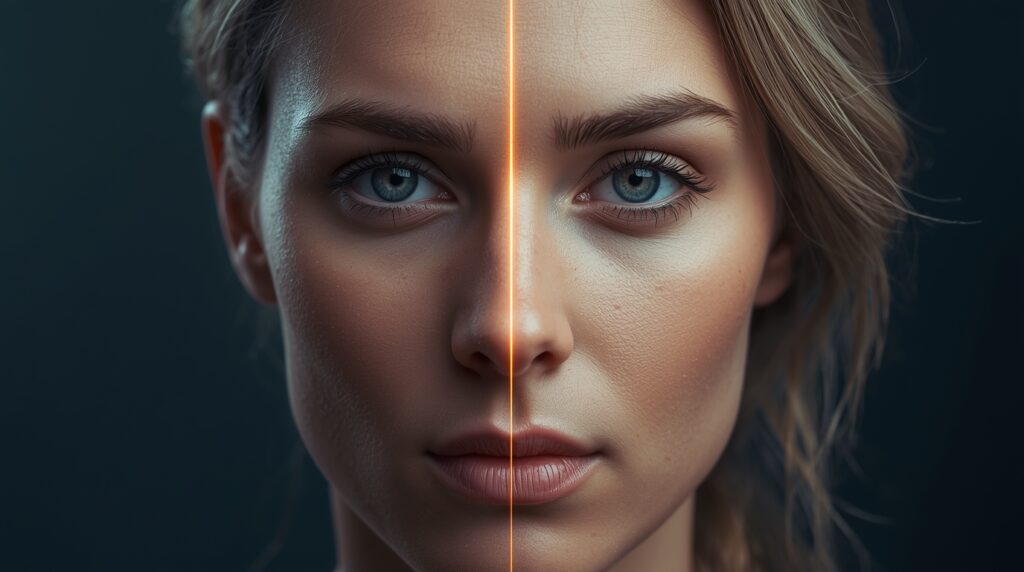Introduction
Ever looked at two photos and thought, “If only I could blend these faces perfectly”? Yeah, me too. I remember the first time I tried merging two portraits manually in Photoshop it took hours, and the result looked like something from a 2008 sci-fi movie gone wrong. That’s when I discovered mawshot stitch ai, and everything changed.
This tool isn’t your average photo editor. It doesn’t just paste images together it understands them. It feels like working with a silent artist who just gets your vision.
If you’ve ever wanted to create ultra-realistic AI portraits that look like they were shot by a pro photographer, this is the guide you didn’t know you needed.
What Is Mawshot Stitch AI and Why Everyone’s Talking About It
Let’s keep it simple. Mawshot stitch ai is a tool that uses advanced AI diffusion models to merge multiple portraits into one seamless, hyper-realistic image. Instead of forcing pixels together, it studies the lighting, facial structure, and even the texture of skin then stitches everything naturally.
It’s like blending two souls into one photo. Creepy? Maybe a little. But impressive? Absolutely.
The tool is often compared with AI models hosted on Hugging Face or CivitAI, where communities share different versions of diffusion models for portrait realism.
So whether you’re a digital artist, game designer, or just someone who loves experimenting with tech, mawshot stitch ai can completely transform your creative workflow.
Getting Started with Mawshot Stitch AI
Before you dive into the deep end, you’ll need a few basics. The good news? You don’t have to be a tech genius to get started.
Here’s what you’ll need:
- A decent GPU or online access to the tool (some versions run on the cloud).
- Stable internet if you’re using web demos or model spaces.
- A bit of patience — AI rendering can take a few minutes.
Most creators use the community versions of mawshot stitch ai available on GitHub forks or AI art-sharing spaces. Just search for “Mawshot Stitch AI model” and you’ll likely land on a working interface.
The interface usually has:
- Prompt input box (where you type what you want to create)
- Image upload area (for reference photos)
- Blend controls (how strongly to merge features)
- Generate button (the fun part)
Hit that, and in about 30 seconds, you’ll see your first blended face something that looks both familiar and strangely new.
Crafting the Perfect Blend (The Art of Stitching Right)
Here’s where things get creative. Anyone can hit “generate,” but getting that perfect merged portrait takes a bit of skill — or at least intuition.
Step 1: Choose Your Sources Carefully
The magic of mawshot stitch ai lies in balance. If your source photos have wildly different lighting or head angles, the AI can get confused. Pick two images that look like they could’ve been taken in the same studio.
Step 2: Write a Smart Prompt
Don’t overcomplicate it. Try something like:
“Ultra-realistic portrait of a person combining facial features of image A and B, cinematic lighting, 85mm lens photography, detailed skin texture.”
The more grounded your prompt, the better. Think of it like giving a photographer a brief clarity matters more than adjectives.
Step 3: Adjust the Stitch Strength
Most interfaces have a “blend ratio” or “stitch weight.” Too high, and the image may distort. Too low, and you’ll barely see the merge. Try values between 0.4–0.6 for natural results.
You’ll learn by feel the more you play, the better you’ll get.
Realism Is All About Light and Texture
When you’re blending portraits, lighting consistency is everything. Mawshot stitch ai can read tone and color balance, but if your inputs fight each other like one in sunlight and the other in a dim room it’ll struggle.
Try describing lighting in your prompt:
“Soft studio lighting from the left, natural shadows, warm tones.”
Small details like that completely change the outcome. I’ve seen portraits come alive just by adding “reflected amber light from a window”. It’s that subtle.
And if you’re serious about photo realism, use reference styles. You can explore Lexica Art for inspiration and prompt phrasing ideas — it’s like a visual dictionary for AI creators.
Fixing Common Problems in Mawshot Stitch AI
Even the best AI makes mistakes. I’ve had outputs where eyes looked mismatched or the jawline melted into the background like wax. But the fixes are easy once you know what to look for.
Here’s what helps:
- Weird facial blending: Lower the stitch strength and re-render.
- Lighting mismatch: Add specific lighting cues to your prompt.
- Color tone issues: Post-edit in Photopea or Lightroom.
- Overly sharp or plastic skin: Try a lower sampling step count (around 25).
Sometimes, a single tweak changes everything. Don’t delete a bad result learn from it.
Why Mawshot Stitch AI Feels More Human
I’ve used plenty of AI tools, but there’s something different about mawshot stitch ai. It doesn’t feel mechanical. There’s an understanding of expression the way the eyes align, the slight asymmetry that makes faces real.
This AI doesn’t just paste one face over another. It interprets emotion and structure, like it knows what makes a person look real. That’s what sets it apart from regular blending tools like Photoshop or Runway ML.
It’s almost unsettling when you realize how good it’s become. But that’s what makes it exciting AI is learning aesthetics, not just math.
Taking It to the Next Level: Post-Editing for Perfection
Even with a great base, the final touches matter. Export your image at high resolution (if possible, 2048×2048 or above), then:
- Use Lightroom to tweak contrast and temperature.
- Apply Topaz Labs Gigapixel for upscaling without losing detail.
- Add background blur to enhance focus.
And if you’re creating portraits for professional projects, like brand art or digital campaigns, make sure you check commercial usage rights. Most models on CivitAI list licensing details clearly.
Ethics and Responsible Use
It’s easy to get carried away when technology gets this powerful. But blending faces even fictional ones — comes with responsibility. Avoid using real people’s photos without consent. Never try to “recreate” a celebrity or public figure; that’s a quick way to cross legal and ethical lines.
AI art can be fun, but it’s still art respect boundaries. Create, don’t impersonate.
The Future of Face Merging
It’s wild to think about where this tech is heading. Soon, we might see mawshot stitch ai adding micro-expression control smiles that feel genuine, eyes that show emotion.
Imagine typing “merge two portraits of siblings into one realistic family resemblance” and getting a perfect result in seconds. It’s not far off.
Every new model brings sharper detail, better lighting logic, and faster rendering. The line between a “real” and “AI-generated” portrait is blurring fast — and honestly, it’s beautiful to watch.
Conclusion
When I first used mawshot stitch ai, I expected something gimmicky maybe a cool filter at best. But what I found was a tool that’s part science, part art, and entirely addictive. It’s not just merging photos; it’s creating people who never existed, yet somehow feel real.
If you love experimenting with visuals, storytelling, or just pushing creative limits, you’ll find this tool endlessly fascinating. Play with it, fail with it, master it that’s where the real magic lies.
The world of AI art is still unfolding, and mawshot stitch ai is one of those rare tools that makes you stop and think: “Wow, so this is the future of creativity.”

